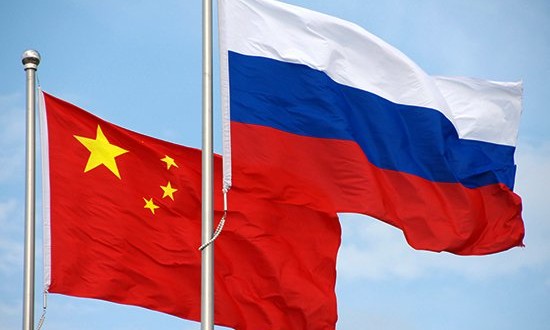Since the late 1990s, China’s world expansion has been accelerating, and also extending beyond the geographical borders of Siberia and of the so called Russian Far East.
If the western world perceives this Chinese progress in the light of its own standards as a process of “colonization” (an illegal action according to a whole category of states that have practiced it in previous centuries), how would Russia and Russians react to their lands and resources being taken into possession when Trans-Baikal[1] signs a lease for 150,000 hectares of farmland for 49 years[2] with a Chinese company?
Figure 5: Russia-China map
Change in progress – porous border, symbiotic systems
The Chinese overflow pours down on the Siberian desert
China and Russia share about 4,300 km of common borders, partially limited by the Amur River. On one side of the river, there are 1.4 billion Chinese, ¼ of the world’s population owning only 7% of the world’s arable land[3] and having an extreme need for food resources (China is the largest importer of agricultural products[4]). The border region of Heilongjiang[5] alone has 40 million inhabitants. On the other side, 39 million inhabitants (one million less than in the Chinese region of Heilongjiang), representing ¼ of the Russian population, occupy 60% of Russia’s territory, the Russian Far East[6], numbering 6.5 million inhabitants with a distribution of 1.2 inhabitants per square kilometre. It is a very wealthy desert, almost totally untapped, but getting increasingly vacant, due to the decreasing birth rate in Russia and the migration of Siberian inhabitants (many of them are moving to western parts of their continent[7]).
China offers very cheap labour (the Chinese wages being lower than those of the Russian workers) contributing to deserted and impoverished territories, abandoned both by Russians and their central government, obsessed with the declining splendours of the West.
Land against money, but not only …
Figure 6: The Chinese-Russian partnership, 2009-2018 – Source CAIRN
“We give land, they give money”
China uses all possible means to ensure its expansion: exploitation of farm land, exploitation of forest areas[8], construction of road infrastructure and of high speed rail services connecting Chinese cities to Vladivostok[9], transportation lines for goods to Yekaterinburg[10], and also to other destinations in western countries like Germany, France, and Iran. In addition, these include border raisings along the Chinese-Russian road network[11], allowing the drawing of direct lines between China and Russia, bypassing Mongolia or less secure countries like Kyrgyzstan and Kazakhstan, multiplication of free border areas for commercial transactions[12], and massive investment in the construction of oil and gas pipelines bringing Russian oil and gas to China. Furthermore, it allows direct use of energy resources through windfall contracts[13], real estate investments, and so on and so forth. This policy is being strongly supported by the Chinese banks and institutions through financial transaction agreements in rubles[14], through bank loans given to Russian companies and individuals, or even the swap agreement between the central banks[15]…
For Siberian regions, such as the Trans-Baikal or the Russian Far East, this is an endless financial windfall. Indeed, although the central government has launched various developmental plans, the investments get stuck in the pockets of oligarchs and higher level apparatchiks, while corruption is flourishing (something for which the Chinese are also criticized ).
Russian and Chinese interests are compatible
Figure 7: Russia-China Trade – Source: RT
China is Russia’s biggest trading partner since 2014. The total trade between them represents 11% of the Russian trade. China and Russia have set a target of $200 billion per year by 2020, which will undoubtedly be exceeded given the huge amounts of the agreements between these two states[16].
It’s a win-win relationship: Russia has been suffocated by European sanctions for five years now, and it needs to develop new markets to revive the country’s economy, all this with a prospect for a much longer term than it could imagine; China, searching for stabilization, needs to be closer to its supply sources:
. leasing of farmland, which brings significant cash into the coffers of the Russian state (leasing + tax) and provides a stream of 80% of this agro/forestry production to China
. or long-term contracts for energy supply, oil/gas[17]/electricity[18], which ensure long-term revenues to Russia (contract duration of 30 years), and investments[19] (China has committed to partially finance the transportation costs), and to provide China with a reliable neighbouring partner, guarantee for stability of supplies, transport security, reasonable cost and environmental protection.
Although China has just embarked on a huge program of $50 trillion for clean energy production, expected to be operational in 2050[20], it remains dependent in terms of imports: 60% of its oil and 30% of its gas. While in 2010 Saudi Arabia was its main supplier, Russia took over the top spot and now allows yuan transactions[21] (a significant advantage).
Russia needs China to keep its currency afloat (especially as the yuan is now part of the basket of international currencies). Russia needs the Chinese market to circumvent the EU sanctions and the economic and financial shortfall caused by the closure of the EU market and its partner markets (we could see here what might be the economic and financial impact on a country like Russia once the TTIP agreement is implemented).
At the same time, China needs Russia to “boost” the number of transactions in yuan and dilute the petro-dollars into petro-yuans.
China needs Russia to ensure the success of the new Silk Road mega-project, a conquest of roads and economic/trade opportunities to the West. The roads definitely pass through some of the territories of the Russian Federation, where China cannot ensure a manu-militari security for its convoys[22]. Russia is counting on China to help ensure geopolitical stability in its extreme south western regions[23].
The sulking West seals a Russia-China alliance
Since 2009/2010, with the war in Ukraine and the Cold War between NATO and Russia, a stop was put to Russia’s attempted westernization. Putin’s Russia (having believed it could achieve this reconciliation with Europe, highly dreamed of for centuries, but brutally interrupted by over 70 years of communist and Stalinist obscurantism), finds itself cornered in its Eastern borders: deterioration of neighbourly relations on its western flank, sanctions imposed by the western camp, and a powder keg in the extreme south of the federation (in the Caucasus, NATO is working with Armenia, Azerbaijan and Georgia – the “South Caucasus” – and in Central Asia, with Kazakhstan, Uzbekistan, Kyrgyzstan, Tajikistan and Turkmenistan[24]).
China, on the other hand, is accused of colonial expansionism by the very people who have practiced this in past centuries with all the consequences that we know about in the present world situation. It should confront the belligerent forces which come claiming land (islands) in the South China Sea which do not belong to them more than to others[25] (the South China Sea has always been considered a common area without national affiliation, a purely Western concept) and causing forced water boundary manoeuvres, or attempting to stir up fear of Chinese hegemony in Asia.
Russia, tired of its frustrating westernization efforts, and China, annoyed on its Eastern flank, run into each other’s arms driven by some transatlantic interests frightened by their emergence: the purveyors of “divide in order to rule” seem to be a strategic failure for this alliance of their two main opponents… unless these interests rely on the fact that this “unnatural” pact will result in conflict between the two powers, ultimately exterminating each other when contact is created. Yet, let’s avoid entering certain “logical” insane minds which do not actually control much. The world’s dynamic is increasingly moving away from the dusty trenches of Washington or Brussels.
2020 – Potential conflicts in a trans-regional area
“Do not ‘Own’ Land, just ‘Use’ It”
China is watching the American positions with great interest (in 2010, Obama proposed a policy change with regard to Russia[26]), and the mood swings in Russian public opinion, naturally more focused on a neighbourly relationship with the West than with China. 70% of the Russian population lives in the western regions of the country, thus more than 8,000 km away from the Far East Russia.
The concept of a Chinese invasion, regularly waved like a red flag by a rather sinophobic Russian-western media[27], is still firmly rooted in people’s minds. It is very hard to number the Chinese population in Russia, about 400,000 people, most probably, but the figure may be higher. If we trust the documentary aired on ARTE in March, about 140 million Chinese are likely to settle there[28], so we could easily understand that such a figure could stir up fear.
Even if China does not intend to put into practice the politics of land ownership, the question of how the transmission of the leased land will be handled after 49 years of exploitation remains open. Will China annex any land which historically once belonged to it[29]? And although most conflicts have been officially settled, the complaints are numerous, on both sides, the way it happens with many border regions.
Another point of contention would be the protection of the environment. Siberia is one of the largest natural reserves in the world, teeming with virtually untapped resources.
Despite a proactive policy on sustainable development and a commitment made by the Chinese government, after the COP21 in particular, when it comes to exploiting their own clean energy[30], the Chinese have the bad reputation of not respecting the environment and practicing the scorched-earth policy. With intensive exploitation and use of harmful products, particularly in soybean cultivations, they would most probably abandon some depleted and polluted land … (while Russians are supposed to be ardent climate protectionists).
More than the Chinese, China itself could represent a danger to the regional stability, to Russia, but also to its relations with India. Definitely, the new Silk Road it intends to develop would inflame tensions between China and Russia because of infrastructure and land use, the relationship with India being also in danger, since naturally the latter does not expect interference on its territory. Also, the Tibet issue is still an open wound.
Finally, the history of Siberia shows that the indigenous population is more Turkish (it is commonly accepted that the Turkish people are coming from Central Asia and Siberia) than Chinese or Russian in reality.
2050 – Toward a common space named Siberia
Although the concept of nation-state visibly regains some strength from time to time in a world in crisis, borders have very little future in this 21st century – due to the internet, to name just one proof.
The Chinese have understood it, and they have started to point out the idea of a South China Sea belonging to its residents. Also, in Siberia there is no question about their “invasion” or “occupation” of those territories. Everything is negotiated and paid for. Moreover, the Chinese nationals are instructed to learn Russian and get integrated. The border is in no way contested; it is simply transformed into a dividing line, imposing dialogue and materializing exchanges. In the end, of course, it will most probably not even make any more sense and be deleted…
But where Westerners have trouble imagining anything other than a flag – Chinese, Russian or Turkish – flying over the Siberian territory, wouldn’t it be better to see this desert like a sea, an open space of communication, criss-crossed by human flow and exchange of goods and information, accelerated by these communication channels in which Chinese are currently investing.
On this sea, island-cities are ethnic and cultural identity places, imposing respect and changing further to human settlements.
As for the massive Siberian resources, can the Russians be their guardians forever? Is military spending (imposed by the status) actually offset by the benefits that resource trade brings in return? Will the twenty-first century, and the promised increased intelligence (once we have overcome the failures of transition with the previous century), complete this concept invented (and murdered) by Europe after two world wars, of sharing natural resources[31], with the aim of stopping the killing?
Siberia might appear as a laboratory for this kind of experience, in this case: a sea full of fish managed by a community of residents gathered around the same table and on the initiative of Russia, the welcoming land.
“Conflict Is a Choice, Not a Necessity“[32]
[2] Source: FranceTV Info, 01/07/2015
[4] Source: Plein Champ, 14/04/2015
[7] « In recent years, the region of Magadan was abandoned by 57% of the population, Kamchatka Peninsula by 20% and the Sakhalin Island by 18% ». Source: BDLP 04/04/2016
[8] Source: Huffington Post, 29/06/2015
[11] Source: French Poeple, 18/02/2016
[13] Source: Courrier International, 03/09/2014
[14] Source: Economic Times, 09/08/2015
[15] Source: Réseau International, 19/06/2015
[16] Source: Réseau International, 26/09/2014
[21] Source: Wikistrike, 25/06/2015
[25] A conflict with Japan that could have ended in 2014, when the US avoided to interfere. Source: Le Monde, 24/04/2014
[26] Source: White House, 24/06/2010
[27] See the articles quoted in France TV Info, 03/07/2015
[30] Thus, the 13th five-year plan adopted on March 16 by the Chinese Assembly proposes high objectives of greenhouse gas emissions and air pollution reductions. – Source: Sciences et Avenir, 20/03/2016
[31] We remind you that the European Community was born from CECA, which put coal and steel together.
[32] A quotation of Henri Kissinger – Source: Foreign Affairs, March/April 2012


 LEAP2040 Toutes les informations et archives Europe2040
LEAP2040 Toutes les informations et archives Europe2040






